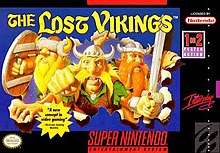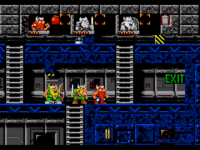The Lost Vikings
| The Lost Vikings | |
|---|---|
 Packaging for the Super NES version. | |
| Developer(s) | Silicon & Synapse |
| Publisher(s) |
Interplay Productions Blizzard Entertainment (Game Boy Advance) |
| Designer(s) | Ron Millar |
| Composer(s) |
Allister Brimble (Amiga and Amiga CD32 conversion) Charles Deenen (original SNES music) Matt Furniss (Genesis music) Glenn Stafford (DOS conversion) |
| Platform(s) | Amiga, Amiga CD32, Game Boy Advance, MS-DOS, Mega Drive/Genesis, Super NES |
| Release | 29 April 1993[1] (SNES), 2003 (GBA) |
| Genre(s) | Puzzle, platformer |
| Mode(s) | Single-player, cooperative |
The Lost Vikings is a puzzle-platform video game developed by Silicon & Synapse (now Blizzard Entertainment) and published by Interplay. It was originally released for the Super NES in 1993,[2][3] then subsequently released for the Amiga, Amiga CD32, MS-DOS, and Mega Drive/Genesis systems the next year; the Mega Drive/Genesis version contains five stages not present in any other version of the game. Blizzard re-released the game for the Game Boy Advance in 2003. In 2014, the game was added to Battle.net as a free download emulated through DOSBox.[4]
In The Lost Vikings, the player controls three separate Vikings with different abilities. The three Vikings must work together to finish each level and find their way back home. A sequel, The Lost Vikings 2, was released in 1997.
Plot

Three Vikings—Erik the Swift, Baleog the Fierce, and Olaf the Stout—get kidnapped by Tomator, emperor of the alien Croutonian empire, for an inter-galactic zoo. They are able to escape the ship, but get lost in various periods of time. They must traverse various bizarre locations, and eventually confront and defeat Tomator, to find their way home.
Gameplay
The Lost Vikings is a side-scrolling platform adventure in which the player alternates control of the three Viking characters, guiding each of them one at a time (though control may be swapped from character to character at any point) from a designated start point in each level to the exit (The game offers a two-player cooperative mode in which each player simultaneously controls one Viking and is allowed to change control to the third, unused Viking at any point). Every level is designed such that each Viking must contribute his unique skills to help the other two through to the end. Similarly, to finish the level, all three characters must reach the exit point. The Vikings each have three health points which they can lose by getting hurt by enemies or by falling from great heights. Should any Viking run out of health points, he dies; gameplay will then continue with any remaining Vikings, but the level becomes unwinnable, and the player will eventually have to restart the level and try again (the game offers unlimited continues).
Each Viking has the ability to carry and use items—such as keys, bombs, and food (which restores health points)—as well as a unique set of skills:
- Erik can run faster than the other two, can jump, and can bash through some walls (and enemies) with his helmet.
- Baleog can kill enemies with his sword, or from a distance with his bow (and a "life-time supply of arrows"). The bow can also be used to hit switches from a distance.
- Olaf can block enemies and their projectiles with his shield, and use his shield as a hang glider. Olaf's shield can also be used as a platform for Baleog to walk over and to allow Erik to reach higher areas.
Reception
| Reception | ||||||||||
|---|---|---|---|---|---|---|---|---|---|---|
| ||||||||||
Computer Gaming World in 1993 called The Lost Vikings "a clever blend of comedy and role playing". The magazine concluded that "the game is a unique puzzle solving adventure, great for people who enjoy using their cerebral cortex along with their eye to hand coordination".[9] Zach Meston of VideoGames & Computer Entertainment praised the difficult puzzles, humor, distinctive visual style, personable character animation, and upbeat music. He summarized the game as "funny, fresh and challenging enough to keep you playing for hours on end."[8]
Electronic Gaming Monthly in 1994 remarked of the Genesis version that "The music doesn't have the kick of the [Super NES] version (or the truly colorful graphics)", but that it is generally a well done conversion of "a really good puzzle game".[7] Mega placed the game at number 22 in their Top Mega Drive Games of All Time.[10] AllGame stated that it was "methodically paced and intelligently designed" and that "The nice graphics combined with the funny (and sometimes helpful) dialogue gives The Lost Vikings more personality than most other video games. To top it off, the controls are sharp, and the level of challenge is high without being frustrating."[5]
References
- ↑ http://www.mobygames.com/game/snes/lost-vikings/cover-art/gameCoverId,170152/
- ↑ "Classic Games". Blizzard Entertainment.
- ↑ "The Lost Vikings". MobyGames.
- ↑ Wawro, Alex (May 2, 2014). "Rock n' Roll Racing, The Lost Vikings now free on Battle.net". Gamasutra. Think Services. Retrieved May 2, 2014.
- 1 2 Weiss, Brett Alan. "The Lost Vikings". AllGame. Archived from the original on 11 December 2014. Retrieved May 26, 2017.
- ↑ Weiss, Brett Alan. "The Lost Vikings". AllGame. Archived from the original on 11 December 2014. Retrieved May 26, 2017.
- 1 2 "Review Crew: The Lost Vikings". Electronic Gaming Monthly. No. 54. Sendai Publishing. January 1994. p. 46.
- 1 2 Meston, Zach (May 1993). "The Lost Vikings". VideoGames & Computer Entertainment. No. 52. L.F.P., Inc. p. 48.
- ↑ Wilson, David (December 1993). "Vikings Just Wanna Have Fun". Computer Gaming World. p. 222. Retrieved March 31, 2016.
- ↑ Mega magazine issue 26, page 74, Maverick Magazines, November 1994
